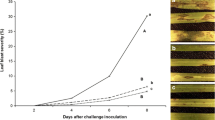Abstract
Two strains of rice-associated pseudomonads Pseudomonas fluorescens 7-14 and P. putida V14i caused an induced systemic resistance (ISR) in three cultivars of rice. ISR response coincided with increased levels of salicylic acid and biological suppression (25%) of rice blast disease. When the strains of the bacteria with lacZY molecular marker tracking system were applied to rice seeds as a seed-coat, they persisted on rice roots for entire duration of the crop (110 days) but migrated to the rice shoot only up to 14 to 16 days. Bacteria applied as a root-dip did not migrate to aerial parts of the rice plant. Bacteria infiltrated into the rice stem survived for 20 days after the treatment and were not detected on the surface of the stem. It is suggested that the ISR triggered by these bacteria which were spatially separated from the rice blast pathogen, is an important mechanism for the biological suppression of rice blast.
Similar content being viewed by others
References
Chatterjee, A., Valasubramanian, R., Ma, W-L., Vachhani, A.K., Gnanamanickam, S. & Chatterjee, A.K. 1996 Isolation of ant mutants Pseudomonas fluorescens strain Pf7–14 altered in antibiotic production, cloning of ant + DNA, and evaluation of the role of antibiotic production in the control of blast sheath blight of rice. Biological Control 7, 185–195.
Gnanamanickam, S.S. & Mew, T.W. 1992 Biological control of blast disease of rice (Oryza sativa L.) with antagonistic bacteria and its mediation by a Pseudomonas antibiotic. Annals of the Phytopathological Society of Japan 58, 380–385.
Krishnamurthy, K. & Gnanamanickam, S.S. 1997 Biological control of sheath blight of rice: Induction of systemic resistance in rice by plant-associated Pseudomonas spp. Current Science 72, 331–334.
Leeman, M., Van Pelt, J.A., Den Ouden, F.M., Heinsbroek, M., Bakker, P.A.H.M. & Schippers, B. 1995 Induction of systemic resistance against Fusarium wilt of radish by lipopolysaccharides of Pseudomonas fluorescens. Phytopathology 85, 1021–1027.
Raskin, I., Rurner, I.M. & Melander, W.R. 1989 Regulation of heat production in the inflorescences of an Arum lily by endogenous salicylic acid. Proceedings National Academy of Science USA 86, 2214–2218.
Ryals, J., Uknes, S. & Ward, E. 1994 Systemic acquired resistance. Plant Physiology 104, 1109–1112.
Silverman, P., Seskar, M., Kanter, D., Schweizer, P., Metraux, J.-P. & Raskin, I. 1995 Salicylic acid in rice. Plant Physiology 108, 633–639.
Author information
Authors and Affiliations
Corresponding author
Rights and permissions
About this article
Cite this article
Krishnamurthy, K., Gnanamanickam, S. Short Communication: Induction of systemic resistance and salicylic acid accumulation in Oryza sativa, L. in the biological suppression of rice blast caused by treatments with Pseudomonas spp.. World Journal of Microbiology and Biotechnology 14, 935–937 (1998). https://doi.org/10.1023/A:1008872925755
Issue Date:
DOI: https://doi.org/10.1023/A:1008872925755




